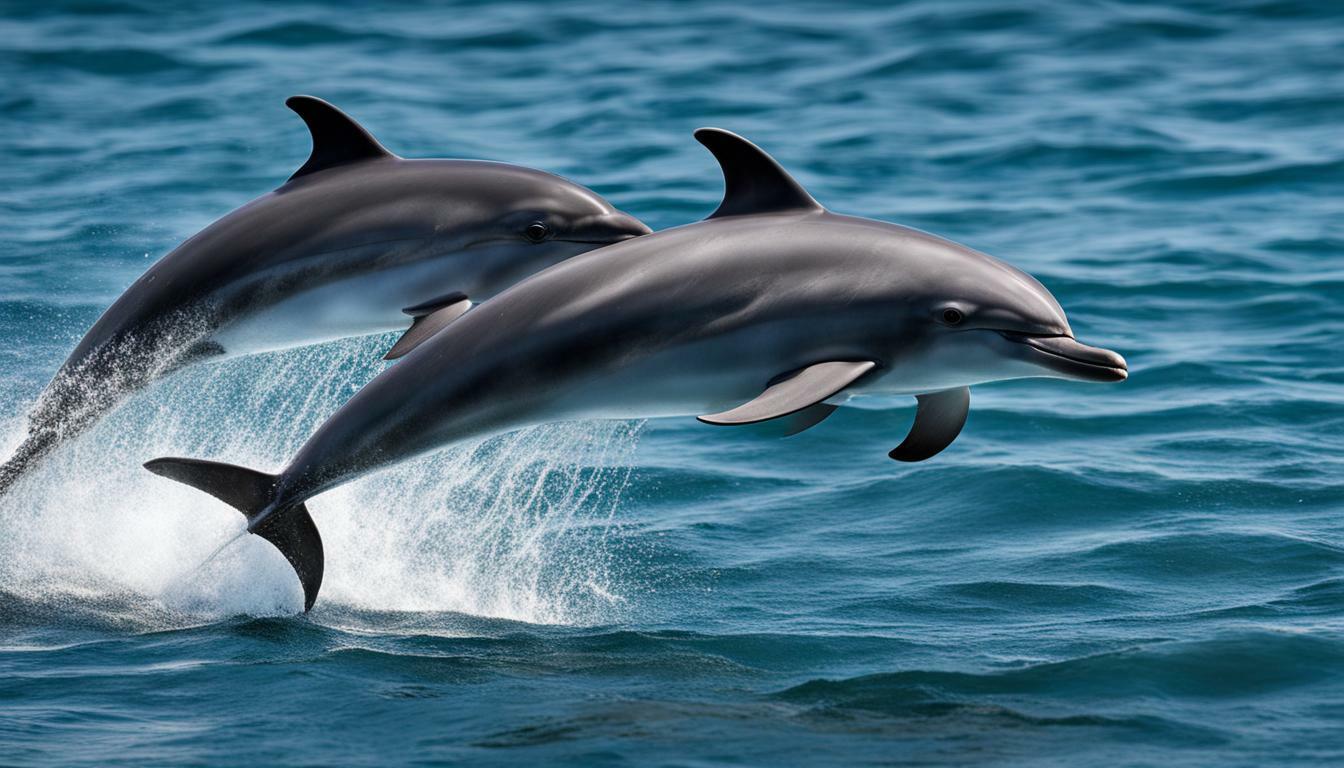Welcome to our comprehensive guide on dolphin species and subspecies, where we dive deep into the fascinating world of these intelligent marine creatures. Dolphins are known for their incredible intelligence, social behavior, and graceful movements through the water. In this article, we will explore the various species and subspecies of dolphins, shedding light on their diverse characteristics, habitats, and conservation status.
Understanding Dolphin Classification and Diversity
Dolphins belong to the family Delphinidae and are known for their remarkable diversity, with numerous species and subspecies populating the world’s oceans. These intelligent marine mammals are highly adapted to their aquatic environment and have captured the fascination of scientists and nature enthusiasts alike. In this section, we will delve deeper into the classification and diversity of dolphins, shedding light on the rich tapestry of their existence.
To explore the classification of dolphins, we can turn to the comprehensive guide provided by the renowned book, “Handbook of Whales, Dolphins, and Porpoises of the World.” Authored by esteemed conservationist Mark Carwardine and leading cetacean biologists, this invaluable resource offers detailed information on every cetacean species and subspecies. It includes nearly 1,000 color illustrations, annotations, and distribution maps, allowing readers to gain a deeper understanding of these incredible creatures.
Within the family Delphinidae, dolphins are further organized into various taxonomic groups, including tribes, genera, and species. Each species represents a distinct branch of the dolphin family tree, with distinct characteristics and adaptations. Throughout this section, we will explore the different taxonomic groups and delve into the wide variety of dolphin species and subspecies found around the world.
Dolphin Classification Overview:
| Taxonomic Group | Example Species |
|---|---|
| Tribes | Delphinini, Globicephalini |
| Genera | Tursiops, Orcinus, Delphinus |
| Species | Common Bottlenose Dolphin (Tursiops truncatus), Killer Whale (Orcinus orca), Common Dolphin (Delphinus delphis) |
As we explore the incredible diversity of dolphins, we will highlight their unique characteristics, habitats, and adaptations. From the acrobatic leaps of the Common Bottlenose Dolphin to the majestic presence of the Killer Whale, each species offers a glimpse into the remarkable world of these marine mammals. Prepare to be enthralled by the wonders that await as we embark on this journey through the captivating realm of dolphin diversity.
Exploring Various Dolphin Species
From the iconic bottlenose dolphins to the acrobatic spinner dolphins, the dolphin family encompasses a wide array of species, each with its own distinct traits and behaviors. These intelligent and social marine mammals have captured the fascination of humans for centuries. In this section, we will take a closer look at some of the different dolphin species that inhabit our oceans.
1. Bottlenose Dolphins
One of the most well-known and widely recognized dolphin species is the bottlenose dolphin. They are known for their friendly demeanor and are often seen riding the bow waves of boats or performing playful acrobatics. Bottlenose dolphins can be found in both coastal and offshore habitats, and are known to form close-knit social groups called pods. These dolphins are highly adaptable and can thrive in a wide range of environments, from tropical to temperate waters.
2. Spinner Dolphins
Spinner dolphins are another fascinating species that is known for their impressive aerial displays. They are named for their habit of leaping out of the water and spinning rapidly before splashing back down. These dolphins are found in tropical and subtropical waters and are known for their sociable nature. They often gather in large groups, known as pods, and can be seen performing their acrobatic feats in unison.
3. Orca, or Killer Whales
While technically a species of dolphin, the orca, or killer whale, deserves a mention due to its distinctive appearance and behavior. Orcas are the largest members of the dolphin family and are known for their striking black and white coloration. They are formidable predators and are often referred to as the wolves of the sea. Orcas are highly intelligent and have complex social structures, with different populations exhibiting unique hunting techniques and vocalizations.
These are just a few examples of the incredible diversity within the dolphin family. Each species has its own unique characteristics and adaptations that allow them to thrive in their respective habitats. By studying and understanding these fascinating creatures, we can gain a deeper appreciation for the rich variety of life that exists in our oceans.
Uncovering Dolphin Subspecies
Beyond the overarching dolphin species, there exist fascinating subspecies that have evolved to thrive in specific regions, showcasing remarkable adaptability to varying environments. These subspecies, with their unique characteristics and geographical distributions, provide a deeper understanding of the diversity within the dolphin family.
Table 1: Various Dolphin Subspecies
| Dolphin Species | Subspecies | Geographical Distribution |
|---|---|---|
| Common Bottlenose Dolphin | Tursiops truncatus | Coastal waters worldwide |
| Atlantic Spotted Dolphin | Stenella frontalis | Atlantic Ocean, Gulf of Mexico |
| Pacific White-Sided Dolphin | Lagenorhynchus obliquidens | North Pacific Ocean |
| Spinner Dolphin | Stenella longirostris | Tropical and subtropical regions |
- The Common Bottlenose Dolphin (Tursiops truncatus) is one of the most well-known and widely studied dolphin species. It has various subspecies, each adapted to its specific environment.
- The Atlantic Spotted Dolphin (Stenella frontalis) displays distinctive spots on its body and is commonly found in the Atlantic Ocean and the Gulf of Mexico.
- The Pacific White-Sided Dolphin (Lagenorhynchus obliquidens) inhabits the cold waters of the North Pacific Ocean and is known for its striking black and white markings.
- The Spinner Dolphin (Stenella longirostris) is recognized for its acrobatic displays, spinning and leaping out of the water. It can be found in tropical and subtropical regions worldwide.
“The discovery of these dolphin subspecies is a testament to the incredible diversity within the dolphin family.” – Mark Carwardine, Handbook of Whales, Dolphins, and Porpoises of the World
Insights from the Handbook of Whales, Dolphins, and Porpoises of the World
The “Handbook of Whales, Dolphins, and Porpoises of the World” by Mark Carwardine and leading cetacean biologists offers invaluable knowledge on dolphin taxonomy, providing a wealth of resources for those interested in studying and understanding these magnificent creatures.
This comprehensive book serves as a guide to every cetacean species and subspecies worldwide, including whales, dolphins, and porpoises. With nearly 1,000 color illustrations, detailed annotations, and distribution maps, it is an essential reference for whale watchers and enthusiasts.
The concise text within the handbook covers all 90 species and every subspecies of cetaceans, offering identification tips, information on behavior, life history, and conservation. Its user-friendly layout and informative content make it accessible to both beginners and experts in the field.
Whether you are interested in the diverse world of dolphin species, their classification and diversity, behavior and life history, or the efforts made towards dolphin conservation, the “Handbook of Whales, Dolphins, and Porpoises of the World” is a valuable resource that will deepen your understanding and appreciation for these incredible marine mammals.
| Dolphin Taxonomy | Details |
|---|---|
| Kingdom | Animalia |
| Phylum | Chordata |
| Class | Mammalia |
| Order | Cetacea |
| Suborder | Odontoceti |
| Family | Delphinidae |
Understanding Dolphin Behavior and Life History
Observing dolphin behavior is a mesmerizing experience, as these highly intelligent creatures exhibit complex social systems and engage in various behaviors essential for their survival. Dolphins are known for their playful nature, often seen leaping out of the water and riding on the bow waves created by boats. This behavior, known as bow-riding, not only provides them with enjoyment but also conserves their energy during long-distance travels.
In addition to their playful antics, dolphins also form strong social bonds within their pods. They communicate through a combination of vocalizations, body movements, and even touch. Their intricate social structures are characterized by a hierarchical system, where dominant individuals have priority access to resources and mating opportunities.
When it comes to feeding, dolphins display a variety of techniques depending on their prey. Some dolphins, such as the bottlenose dolphin, use cooperative hunting strategies to corral fish into tight groups before diving in for a meal. Others, like the orca or killer whale, are apex predators and feed on a wide range of marine mammals, including seals and whales.
Dolphin life history is marked by fascinating reproductive strategies. Female dolphins typically give birth to a single calf after a gestation period of around 11 to 12 months. The bond between mother and calf is strong, and the young dolphin depends on its mother for nourishment and protection during the early stages of life. As the calf grows, it gradually learns essential life skills from its mother, including hunting and social behaviors.
| Key Behaviors | Examples |
|---|---|
| Bow-riding | Leaping and riding on boat bow waves |
| Social Bonding | Hierarchical social structures, communication through vocalizations and body movements |
| Feeding Strategies | Cooperative hunting, apex predator behavior |
| Reproductive Strategies | Single calf birth, strong mother-calf bond |
As Mark Carwardine and leading cetacean biologists highlight in their book “Handbook of Whales, Dolphins, and Porpoises of the World,” understanding dolphin behavior is crucial for their conservation. By observing and studying their behaviors, we can gain valuable insights into their needs and help protect their habitats.
Conservation Implications
Dolphin behavior and life history play a significant role in conservation efforts. The observation of certain behaviors, such as bow-riding or feeding strategies, can indicate the health and well-being of dolphin populations. Changes in social bonding patterns or reproductive success can also provide valuable information about the overall population dynamics.
Moreover, understanding the specific needs and behaviors of different dolphin species is crucial for implementing effective conservation strategies. Some species require protected habitats, while others may be more resilient to certain environmental changes. By studying their behavior, we can identify key areas for habitat preservation and ensure the long-term survival of these remarkable marine mammals.
Conservation Efforts for Dolphins
Recognizing the importance of preserving dolphins and their fragile ecosystems, numerous conservation organizations and researchers are working tirelessly to safeguard their future. One such organization is the Dolphin Conservation Society (DCS), dedicated to the protection and conservation of dolphin species worldwide. Through their research and advocacy programs, the DCS aims to raise awareness about the threats faced by dolphins and promote sustainable practices to mitigate these risks.
Efforts to conserve dolphins also extend to international collaborations, such as the Agreement on the Conservation of Small Cetaceans of the Baltic, North East Atlantic, Irish and North Seas (ASCOBANS). This agreement brings together countries in Europe to coordinate conservation measures for dolphins and other small cetaceans in their shared habitats. By pooling resources and expertise, ASCOBANS aims to promote the long-term conservation of these marine mammals and their ecosystems.
Conservation Challenges and Solutions
Dolphins face a multitude of threats that require coordinated conservation efforts. Some of the main challenges include habitat degradation, pollution, accidental entanglement in fishing gear, and climate change. For instance, the construction of coastal developments and pollution from industrial activities can disrupt dolphin habitats and reduce their access to prey. Additionally, the accidental capture of dolphins in fishing gear, known as bycatch, remains a significant concern.
To address these challenges, conservation initiatives focus on implementing measures such as protected areas, habitat restoration projects, and sustainable fishing practices. Protected areas help safeguard crucial habitats for dolphins, ensuring that they have safe spaces to feed, breed, and socialize. Habitat restoration projects aim to rehabilitate degraded areas, enhancing the resilience of ecosystems and benefiting dolphins and other marine species.
Sustainable fishing practices, such as the use of dolphin-friendly fishing gear and improved fishing techniques, reduce the risk of accidental entanglement and bycatch. These practices not only protect dolphins but also support the long-term viability of fishing communities. By promoting the coexistence of dolphins and fishing activities, conservation efforts contribute to the preservation of both marine biodiversity and livelihoods.
Conclusion
Conservation organizations, researchers, and international collaborations play a critical role in the preservation of dolphins and their habitats. Through their dedicated efforts, they strive to ensure that these iconic marine mammals continue to thrive in our oceans. By supporting conservation initiatives and promoting awareness about the importance of dolphin conservation, we can all contribute to safeguarding their future and preserving the beauty and diversity of our marine ecosystems.
| Threats to Dolphins | Conservation Solutions |
|---|---|
| Habitat degradation | Protected areas and habitat restoration projects |
| Pollution | Environmental regulations and pollution reduction measures |
| Accidental entanglement in fishing gear | Dolphin-friendly fishing gear and sustainable fishing practices |
| Climate change | Climate adaptation strategies and mitigation efforts |
Conclusion
Throughout this comprehensive guide, we have embarked on a journey to discover the incredible world of dolphin species and subspecies, gaining a deeper understanding of their classification, behavior, and conservation needs. Immerse yourself in this fascinating realm of dolphin diversity, and let it inspire you to protect and cherish these remarkable marine creatures.
From the diverse taxonomic groups to the wide variety of dolphin species and subspecies found worldwide, we have explored the intricacies of dolphin classification and diversity. We have delved into the characteristics, habitats, and unique features of various dolphin species, shedding light on their rich and fascinating lives.
Moreover, we have unraveled the world of dolphin subspecies, uncovering the different variations and adaptations across geographical regions. By drawing insights from the renowned “Handbook of Whales, Dolphins, and Porpoises of the World,” we have gained valuable knowledge about dolphin taxonomy, distribution maps, and conservation insights.
Understanding dolphin behavior and life history has allowed us to delve into their social structures, communication methods, feeding habits, reproductive strategies, and migration patterns. These insights into their lives not only deepen our appreciation for their complexity but also highlight the importance of preserving their habitats and ensuring their long-term survival.
Lastly, we have discussed the conservation efforts dedicated to protecting dolphins and their precious habitats. By exploring the challenges they face, ongoing research initiatives, and conservation strategies, we are equipped with the knowledge and motivation to actively contribute to their preservation. As we conclude this guide, we invite you to celebrate the immense variety of dolphin species and subspecies and join the global effort in safeguarding their future.







